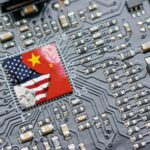
Part 1: How will 2023 play out for some of the top semiconductor companies in the world?(Source – Shutterstock)
Navigating the Currents in Semiconductor Supply Chains
Article by Naresh Narasimhan, President of Pall Corporation
The global semiconductor chip shortage has come into sharp focus in the past two years. Industry megatrends such as remote working, and developments in the Internet of Things (IoT) and artificial intelligence (AI) technologies are creating critical demand for leading-edge semiconductor chips.
On the other hand, supply chain shocks from the pandemic and unprecedented demand have precipitated shortages across the world, and in a number of key industries. Compounding these factors, tensions in the Taiwan Straits and the ongoing chip war between US and China are worsening the current chip shortage. Even with the worst of the shortage for some chips coming to a close late this year, some industries will remain short of chips until 2024. These factors have converged to create the perfect storm for chip shortage – and it is imperative that firms act quickly to mitigate this shortage.
Diversifying semiconductor investment across Southeast Asia
With about 75% of semiconductor manufacturing capacity and supply of key materials concentrated in China and East Asia, it has become clear that geopolitics in Asia have a direct impact on the global semiconductor supply chain. The effects can be dire, with the potential to send shockwaves through more than 200 downstream sectors including electric vehicles, 5G technologies, and data processing equipment.
The shifting structures of East Asia’s geopolitics have prompted several semiconductor firms to expand operations in Southeast Asia. In particular, Singapore’s human capital, infrastructure, and business-friendly environment render it a natural first port of call. Recent estimates put global chipmakers’ investment in Singapore at nearly US$200 billion to mitigate risk and increase supply chain resilience.
Southeast Asia is uniquely positioned as a neutral region, with a well-established and diverse semiconductor ecosystem, as well as being deeply integrated within global value chains. Multinational corporations are waking up to their competitive advantages as part of the regional semiconductor supply chain.
The Philippines, Malaysia, Thailand, Vietnam, and Indonesia have proven to have an adept labor force and talent base to provide support for the backend manufacturing of complex chips. Considering chip complexity outpaces average development productivity by 4.6% annually, building an ecosystem at a strategic location tapping on outstanding local talent to optimize chip performance and energy efficiency makes business sense.

Naresh Narasimhan, President of Pall Corporation
Government support
As businesses navigate the challenge of delivering yet more sophisticated hardware underpinning key industries amid geopolitical shifts, governments can steady the ship by facilitating global access to markets, technologies, capital, and talent. For example, in Singapore, strong government support has enabled semiconductor and related companies to pre-position themselves to maximize growth opportunities, telescoping a large part of the supply chain in a relatively small physical space.
Singapore’s semiconductor industry is an intrinsic part of the global supply chain, creating parts that are required in healthcare, aviation, and device manufacturing. Strategic government support spurs the country’s status as a global business, innovation, and talent hub for advanced manufacturing. Similar ambition is emerging throughout the region, with Malaysia and Thailand also attracting semiconductor investments.
Government collaboration with semiconductor producers can reap long-term rewards, especially if there is assistance in the areas of workforce skills or research and development. Firms operating in key regions like Southeast Asia stand to gain access to markets, talents, and expertise, safeguarding their businesses against future shocks. This arrangement is mutually beneficial for the reciprocating country.
Future-proofing the semiconductor supply chain
Future-proofing the semiconductor supply chain will be no mean feat and will require firms to take a long-term view of disruption and instability. Efforts to implement logistics improvements and build long-term relationships with trusted local and regional distributors as well as developing tech talents are crucial to strengthening supply chain resilience in Asia. This is especially critical since it is forecasted that by 2030, 62% of the world’s semiconductor market share will come from the Asia Pacific, surpassing that of the US and Europe.
Increasing demands from wireless communications, the IoT, electric automotive technology, cloud computing, and artificial intelligence/deep learning are the very innovations that will shape industrial transformation and drive future economic growth. It is imperative for businesses and governments to cooperate and build mutually beneficial partnerships to keep a steady hand on the tiller, as we navigate through supply chain disruption.
The views in this article is that of the author and may not reflect the view of Tech Wire Asia.
READ MORE
- 3 Steps to Successfully Automate Copilot for Microsoft 365 Implementation
- Trustworthy AI – the Promise of Enterprise-Friendly Generative Machine Learning with Dell and NVIDIA
- Strategies for Democratizing GenAI
- The criticality of endpoint management in cybersecurity and operations
- Ethical AI: The renewed importance of safeguarding data and customer privacy in Generative AI applications


